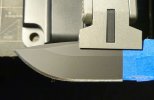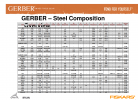- Joined
- Aug 9, 2021
- Messages
- 1,439
Another friend's knife. Good ole' Buck 110.
When you hear about a particular steel being an absolute pain in the butt to sharpen. It's usually some steel that's a dream to run an edge on. They've never tried Buck's 420hc. It's like grinding glass. There's close to an hour in this knife. I started at 400, refined that with 600. The apex was frustrating, but know, it's true and straight.
I'm not done. Oh No, I'm going to run a 1000 grit over it. Then the strop. If this knife had been M4, I would have been done 20 minutes ago. 420hc sucks to sharpen. But it'll shave a frog after I'm done.
I have two Gerber Strongarms with 420HC. Consecutive serial numbers. Both measured 25|19 degrees with the goniometer. The other night, I tried to reprofile one of them to 19 DPS. Both knives have combo blades, so there is only about 3 inches of plain edge to sharpen. I was using the TSProf Kadet with TSProf diamond plates. I've reprofiled S90V before with the diamond plates--not a big deal. After about 40 minutes of grinding with the 150 grit on the 25 degree side, I began to feel a tiny burr. After 55 minutes, I had a burr along the entire edge except at the very tip. Not an impressive burr, but I could clearly feel it. Flipped the knife over. About 45 minutes later, I had a burr on the other side. I've never spent so much time on any knife before, even going through the complete 5 plate progression.
Tonight I did the other Strongarm with the Work Sharp Professional Precision Adjust. After 25 minutes with the 220 grit diamond plate on the 25 degree side, I had a small burr along the whole edge except at the very tip. Flipped. About 13 minutes later there was a burr on the other side. Better than the TSProf, but still way longer than I want to spend on a beater. Way longer than I have spent reprofiling S30V, S35VN, M390, S90V.
Conventional wisdom says that steels with low edge retention are easier to sharpen than steels with high edge retention. How accurate is that? Aside from the really cheap blades that crumble when you try to sharpen them.


